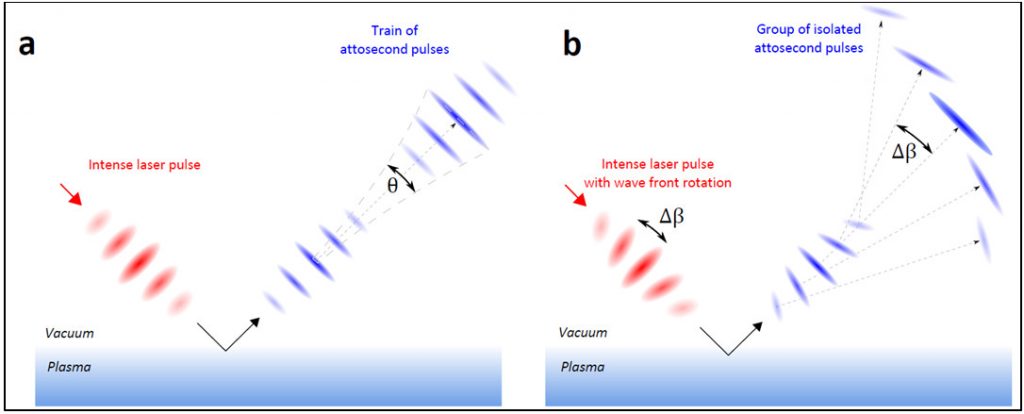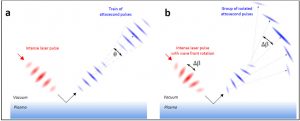Since the dynamics of plasma mirrors is influenced by the phase of the driving laser field, shaping this phase in space-time can provide a very fine control of the emission of attosecond light pulses. This is the idea underlying the attosecond lighthouse effect, which we proposed in [Vin12]. The idea is to induce an ultrafast rotation of the propagation direction of the laser field at focus, by inducing a slight spatial chirp. When such a beam generate attosecond pulses by a non-linear interaction with a medium, successive attosecond pulse produced in different laser cycles are emitted in different directions and, in appropriate conditions, can be spatially separated. This provides a scheme to generate, from a single laser pulse, a collection of angularly-separated beamlets each consisting of a single attosecond pulse. This is called an attosecond lighthouse (see figure 4).

Figure 4: principle of attosecond lighthouses. a, When an intense few-cycle laser pulse interacts nonlinearly with a plasma mirror, the sub-cycle modulation of the temporal laser wavefronts is associated with the generation of a train of attosecond light pulses, which all propagate in a collimated beam along the direction normal to the laser wavefronts at focus. b, When the laser wavefronts are made to rotate in time at focus (wavefront rotation), each attosecond pulse of the train is emitted in a slightly different direction. When the wavefront rotation angle is greater than the divergence of an individual attosecond pulse, this scheme produces a manifold of spatially isolated and temporally synchronized attosecond pulses.
The first experimental demonstration of this effect was obtained in Salle Noire at LOA, in collaboration with the PCO group (see movie below) [Whe12]. The attosecond pulses were produced on plasma mirrors by CWE. It was then demonstrated in the case of attosecond pulses produced in gases, at much lower intensities, in collaboration with Prof. Corkum’s group in Ottawa [Kim13]. There has not been any experimental demonstration for attosecond pulses produced by ROM on plasma mirrors, because it requires a combination of very short laser pulse durations and ultrahigh intensities that is very difficult to achieve experimentally. But several implementations in gases have already been reported in different conditions [Zha15, Sil15] , leading in particular to the generation of broadband XUV pulses, potentially of attosecond duration, in the so-called ‘water window’ spectral range.
Movie of the attosecond lighthouse from plasmas : this movie shows the evolution of the spatial intensity profile of an attosecond lighthouse produced on a plasma mirror by CWE with 5 fs laser pulses, as the CEP of these pulses is scanned. The relative change in CEP is displayed in the upper right corner starting from an arbitrary absolute value. The arrows are reference markers introduced as an aid in visualizing the progression of the individual peaks.
[Kim13] Kim et al, Nature Photonics 7, 651–656 (2013)
[Sil15] Silva et al, Nature Comm. 6, 6611 (2015)
[Vin12] Vincenti & Quéré, Phys.Rev.Lett. 108, 113904 (2012)


